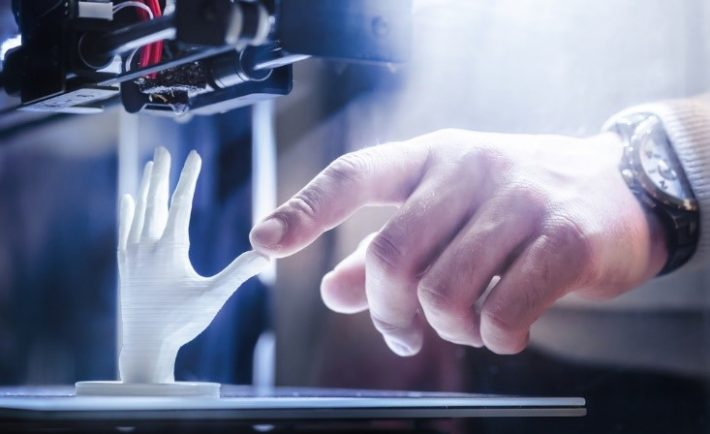3D Printing Healthcare Market to See 18.2% CAGR to 2026, According New Research

Worldwide 3D printing healthcare market is set to reach ~ $3,692 million by 2026-end, unveils the new research study by Ample Market Research (AMR). According to the report, the 3D printing healthcare market is estimated to grow CAGR of 18.2% from 2019 to 2026, the system segment accounted for more than half of the total market share in 2018.
Additive manufacturing, alternately known as 3D printing, refers to a layer-by-layer addition technique of producing a three-dimensional physical object process by using digital 3D design data through a computer aided design (CAD) package. The global 3D printing healthcare market has witnessed dynamic growth in recent years, owing to rapid technological advancements, increase in investments in R&D activities, and rapid expansion of customer base. Furthermore, the customizations offered by this technology, increase in the scope of biomedical applications, efficient material usage, and reduction in cost & time are the major factors supplementing the growth of the market. In addition, the utilization of 3D printing technology in the healthcare sector is anticipated to facilitate effective pre-operative planning, better surgeon practice, enhanced patient outcomes, and suitable alternative to animal testing.
Alternatively, high cost associated with 3D printers, copyright & patent infringement concerns, lack of quality & regulatory frameworks for 3D printers, reimbursement challenges, and concerns regarding mechanical properties & biocompatibility are the key factors responsible for hampering the market growth. Moreover, inadequate technical know-how in developing economies impedes the market growth.
The global 3D printing healthcare market is segmented based on component, technology, application, end user, and region. Depending on component, the market is categorized into systems, software, and services. On the basis of technology, it is segregated into droplet deposition, photopolymerization, laser beam melting, electronic beam melting, laminated object manufacturing, and others.
The applications covered in the study include external wearable devices, implants, clinical study devices, and tissue engineering. The end users of the market comprise medical & surgical centers, pharmaceutical & biotechnology companies, and academic institutions.
The system segment dominated the global 3D printing healthcare market by garnering for more than 50% of share in 2018.
This is majorly attributed to increase in adoption rate of 3D products, advancements in 3D technology, augmented investments in R&D activities for advancement in 3D printers, rapid expansion of the customer base, and increase in biomedical applications. However, the materials segment is anticipated to emerge as a lucrative segment, owing to increase in adoption of 3D systems and rise in utilization of 3D printing technology. The advent of portable and energy-efficient 3D printers are further expected to propel the market growth.
In 2018, the external wearable devices segment led the global market, owing to the presence of large patient pool, liberalization of regulations for 3D printers, increase in adoption of 3D printing technology in dental clinics & hospitals, and customizations.
North America was the highest revenue generator in 2018 due to widespread adoption of 3D printing technology and numerous collaborations between academic and commercial organizations.
Furthermore, the region is anticipated to continue to dominate the global market during the forecast period, owing to technological innovations pertaining to 3D printing, increase in funding for advancement in 3D printers for healthcare, and upsurge in patient pool. In addition, the increase in number of end users has fueled the adoption rate of this technology. However, the Asia-Pacific region is expected to register the highest growth rate during the forecast period. This is attributed to funding received by various start-up companies to introduce advanced 3D printers, escalated demand for advanced medical facilities, and increased healthcare expenditure.
For More Detailed Insights on 3D Printing Healthcare Market Analysis
Key Findings of the 3D Printing Healthcare Market:
The 3D healthcare services segment is projected to exhibit the highest CAGR during the forecast period.
Polymers are the most preferred materials for 3D printing, as they account for about half of the market revenue in the materials market; whereas, the ceramics segment is projected as the fastest-growing segment during the forecast period.
The electron beam melting technology segment is projected to grow at the highest from 2019 to 2026.
The medical and surgical centers end user segment accounts for two-thirds of the market and are expected to dominate the market until 2026.
The tissue engineering application segment would emerge as the fastest growing segment during the forecast period.
North America accounted for two-fifths share of the healthcare 3D printing market, whereas the Asia-Pacific is anticipated to be the fastest growing market, from 2019 to 2026.
The key developmental strategies adopted by leading market players are product launches, collaborations, and partnerships. The prominent market players profiled in this report include 3D Systems Corporation, Exone, Formlabs, GE, Materialise NV, Oxferd Performance Materials, Inc., Organovo Holdings, Inc., Proto Labs, SLM Solutions Group AG, and Stratasys Ltd.
The other players in the value chain include Advanced Solutions Life Sciences, Aspect Biosystem, Cyfuse Biomedical K.K., Envisiontec, and Nano Dimension.















